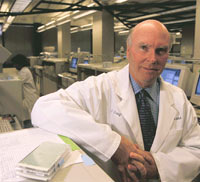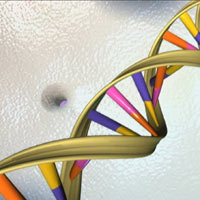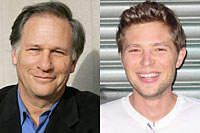
On this page, you'll find regularly updated audio, video, and text reports from our producers and correspondents. We invite you to join the discussion about topics covered here on our board and to subscribe to our audio and video podcasts to download these reports to your computer or MP3 player.

This man, Craig Venter, made a living virus out of store-bought chemicals! 
DNA, life ingredient numero uno 
Robert Krulwich is host and executive editor of NOVA scienceNOW. Jonah Lehrer is a NOVA scienceNOW online contributing editor. He recently completed a Rhodes scholarship at Oxford University's Wolfson College. |
6.30.2005 The Life CocktailRobert Krulwich: So what have you got?
Jonah Lehrer: Well, scientists are getting very, very close to figuring out how to make life. Any day now, a team of scientists might announce that they have created a living thing from a speck of dust. Krulwich: Any day now? Come on.
Lehrer: No, I'm serious. It could happen very, very soon. Already a team of scientists led by Dr. Hamilton Smith, who won a Nobel Prize, and Craig Venter, scientist and entrepreneur, took inanimate matter—store-bought lifeless chemicals—and turned those chemicals into a virus. Krulwich: A real virus? Lehrer: Well, what they created looked like a virus, worked like a virus, did all the things viruses do, except—and they made a big point out of this—it was perfectly harmless. Krulwich: So does that mean that we already have created something alive from something not-alive? Lehrer: Well, it depends on your definition of alive. Krulwich: Viruses seem pretty alive to me. Lehrer: Well, there are those who would tell you viruses aren't living things. They are parasites. They can't exist on their own; they use the truly living things to survive. If a virus didn't have a host, some bacteria to devour, it couldn't copy itself and it couldn't go on living. Furthermore, viruses aren't made of cells. The rest of life is. So a virus is almost a living thing, but it's not quite a living thing. Close, but no cigar. Krulwich: Still, I'm impressed. Shouldn't I be? Lehrer: Oh, this was a Big Deal, in good part because of the way they did it. Krulwich: What did they do? Lehrer: They got the virus to put itself together. They didn't paste the parts into a man-made whole; the virus assembled itself! In two weeks! That's all it took. Krulwich: Hmmm, that's pretty quick. Lehrer: It is quick, but the really amazing part is that it happened on its own. This was the point of their experiment: to show that life, given the proper environment, which in this case was a fancy machine in a laboratory, could generate itself from non-life. After all, science assumes that living things—at least in The Beginning—didn't have a Maker. There was no guiding hand. There was only lots of dead stuff, aimlessly floating around, waiting to interact. So the scientists were trying to figure out if they could get a simple life form to build itself. Krulwich: And it did? Lehrer: And it did. Krulwich: Wow. Do you mind telling me how? Lehrer: Do you really want to know? Cause it's a little, oh, on the complex side. Krulwich: Just tell me already. Lehrer: Okay, okay. The team started by looking on the Internet, where the recipe, the genetic sequence of the virus, is posted. They had to get the exact order of all 5,386 letters of its DNA exactly right. Then the team ordered DNA from an outside company— Krulwich: Say what? You can just buy DNA? Lehrer: It's not even expensive. In fact, it's cheaper than most of the parts you can buy for a Chevy. So, as I was saying, they bought these small pieces of DNA, each about 42 bases long. They then put them in their special machine and waited for the virus to stitch itself together in the correct order, thus creating a copy, a working copy, of the virus. Voila! If you think viruses are alive, then life was made from non-life. Krulwich: Well. I'm speechless. Lehrer: Then why don't you ask me about creating true life? Instead of a virus, can we make something that can exist, copy, and manage on its own? Krulwich: I'm afraid to ask.
Lehrer: Well, in the next segment, or whatever we call these things,
I will tell you about how scientists are actually deconstructing life itself
and figuring out what makes it tick.
This conversation will continue on July 7. In the meantime, if you want to write us, or ask Jonah Lehrer to elaborate, or point out an error, or offer a different point of view, please do so. |
|||||||||||
|
© | Created June 2005 |
||||||||||||